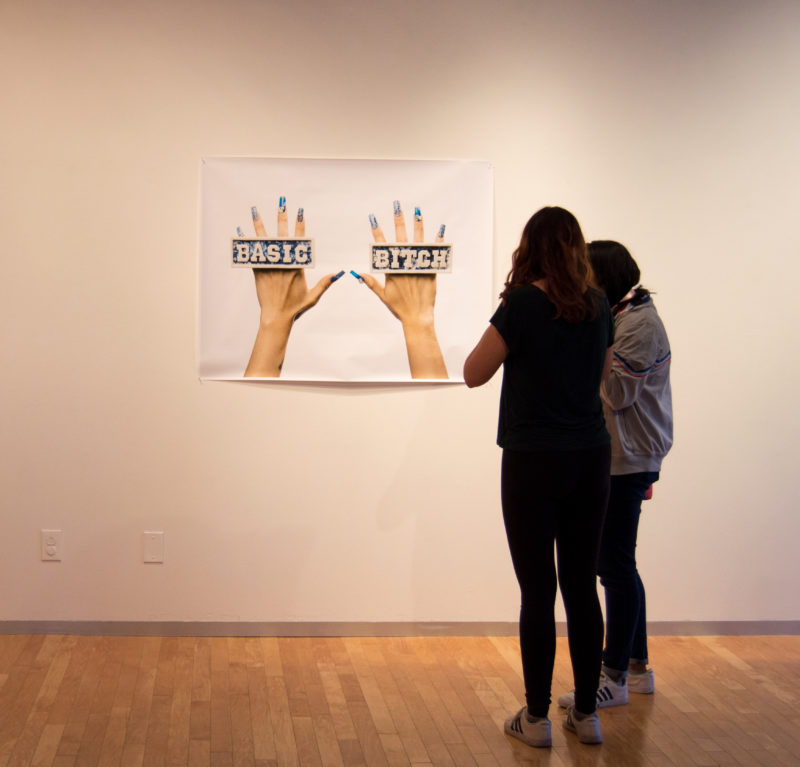Jennifer Ling Datchuk is an artist at the top of her game. Specializing in ceramics, she also utilizes photography and mixed media installations. As a child of a Chinese immigrant and the grandchild of Russian and Irish immigrants, Datchuk consistently speaks on themes of gender, womanhood and biracial identity.
Datchuk has been named a 2017 American Craft Council Emerging Artist as well as a Blue Star Contemporary Berlin Resident and a Black Cube Nomadic Museum Artist Fellow. She is also the mind and hands behind the Porcelain Power Factory, a ceramic initiative that reclaims racist and sexist imagery and raises money for Planned Parenthood.
On Oct. 26, Datchuk opened an exhibition in Trinity’s Neidorff Art Gallery called “Girl You Can.” Ceramic sculpture, video installation, neon lights, blue synthetic hair, photography and textile all share the same space. Datchuk reaches deep into her own experiences and feelings of being a half-Asian woman to start conversation, finding strength through vulnerability.
“I think that “˜vulnerability’ is such a beautiful word because I think it suggests that you are open already, open enough to allow your feelings to be shown on the surface level,” Datchuk said. “I think we live in a world that has us judging everyone on face value. That also, to me, feels important to show.”
In the search for authenticity, it seems we have to meet the world half way and to let our feelings and ideas be easily accessed. The body of work produced by Datchuk primarily seeks an experience with the viewer, where people can relate to her and allow her to relate back to them.
Datchuk, who is biracial herself, emphasizes a feeling of otherness and of being an imposter to both sides of her identity. Conversations about identity with the people around us can elicit anything from genuine curiosity to vicious argumentation, or even intense levels of understanding in regards to how other people live and feel.
“I have to speak the truths in which I live,” Datchuk said.
Datchuk received a classical craft education, focusing primarily in clay work and eventually porcelain, feeling an intimate connection between the material and her Chinese heritage. In the 10 years of art making that have come to pass since graduation, she has incorporated technology and textiles into her work.
“I started thinking about ways information was disseminated. Photography for me was something I started looking into, and of how women were depicted in media,” Datchuk said.
In “Girl You Can,” Datchuk photographs hands wearing ceramic knuckle plates emblazoned with dollar signs and the phrase “˜basic bitch.’ She also films herself painting her face while broken ceramic pieces are simultaneously being washed and manipulated in opaque water. This does not remove ceramics from the work entirely, but creates an additional narrative by showing us an image with ceramics in it.
“I’m once-removing itself from its original state. Which I feel like, as someone who is “˜half,’ I’m always once removed from being acceptable in a culture or ethnicity,” Datchuk said.
She also attributes this diversification of media in her work with building a solid community around herself populated with other artists from which she learns, works with and talks to.
“There’s this stereotype of an artist working alone in their studio. I don’t know where that comes from, I think movies have not done a great job of it, and writing, the way a starving artist is depicted. So much of my work is about working with other people and listening to their stories.”
An active community that encourages exchange is a powerhouse for both communication and education. Datchuk found this to be especially true when confronted with an exhausting election cycle that seemed to leave women and minorities high and dry. Some advice from a close family friend reminded her of that power.
“He said, “˜I feel like you’re trying to make art change the whole world, but take a step back and ask how are you changing your community?’ And that like blew my mind,” Datchuk said. “I really realized I could make an impact by teaching here and also showing here and working with artists here.”
In addition to producing her own work, Datchuk is a professor at the Southwest School of Art. Issues of race and gender weave themselves into this part of her career as well.
“I came to teaching because I didn’t see many schools where professors looked like me. And I think what drove me to teach was being able to provide a voice for students,” Datchuk said.
Going into the arts with a minority identity, according to Datchuk, can be extremely difficult. Many people will have expectations about what work should look like and what it should represent.
“I want to work with students like that, to find their personal voice and to hone their narrative. To work from something that seems very private and to make it public and to find out what things from those experiences become universal. And I think that’s truly the power of art,” Datchuk said.
Datchuk encourages all of her students to work hard and to dig into their communities so that they don’t shy away from what they really want to be saying with their art.
These hopes for young artists are also applied to the viewers of Datchuk’s work, particularly for viewers of “Girl You Can.”
“I hope people start asking questions and thinking about how they curate their sense of identity,” Datchuk said.
The exhibition will be on view at Trinity’s Neidorff Art Gallery through Dec. 9, 1-5 p.m. each day.







